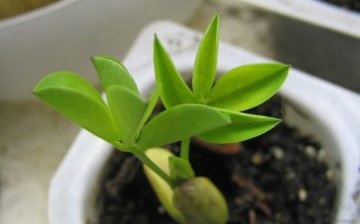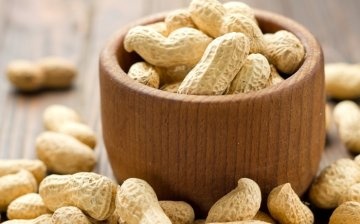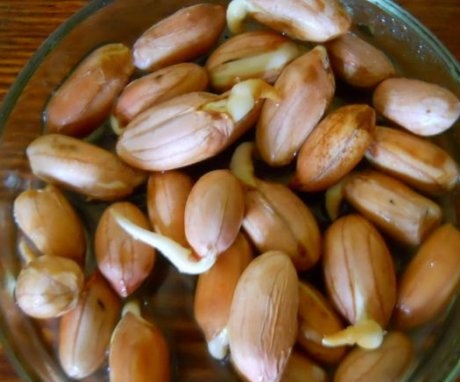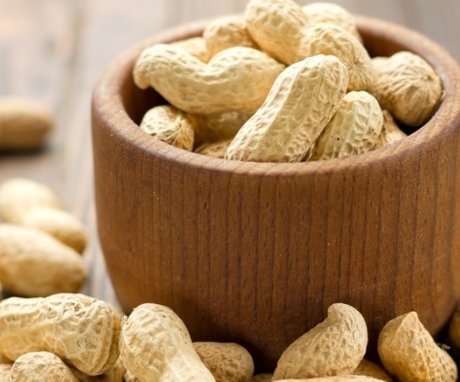How to grow peanuts at home - from planting to grooming
Growing something unusual, exotic, but useful at home is the dream of many gardeners and florists. Peanuts are thermophilic and are not grown in large quantities in the Russian climate, but it is quite possible to try to grow it at home. Peanut bushes are small, so it is very convenient to grow it at home.
Content:
Soil preparation and planting
Growing peanuts at home has its own characteristics. Some gardeners prefer to plant peanuts in open ground, but they grow well in an apartment environment. In addition, there are no birds at home, which often damage and even destroy the crop.
Gardeners who do not know how to grow peanuts at home are advised to first find out the characteristics of the plant itself.
It is a thermophilic, exotic plant. It cannot be called capricious, but there are some subtleties that should be considered:
- Peanut kernels need to be planted germinated... You can choose a raw nut yourself, but it is better to buy seeds in a specialized store, where they guarantee the germination of seeds and determine the variety.
- Place the seed in water and add a drop of epin for better germination. In this form, the seeds are left overnight. By morning they soften and the first roots appear.
- The soil for peanuts should be light and absorb moisture well. Peanuts are used to dry conditions and do not like waterlogging, as well as clay soils that retain water.
- It is best to prepare a 50-50 mixture of sand and humus for peanuts. You can also take care of drainage to avoid moisture accumulation in the ground.
- It is better to choose a wide container for landing right away. Peanuts have one feature: as it grows, its stalk bends to the ground and deepens into it, it is from it that the fruits will develop, so the pot must be wide enough so that the leg can easily reach the soil.
- The seeds are deepened into slightly moistened soil by 2-3 cm, and then covered with glass or film for a while. The seeds can be planted in a box or in different pots at once.
- Germinating seeds should be provided with sufficient heat and light. They may not germinate if the temperature is below 20 degrees.
Care Tips
Peanuts cannot be called whimsical and capricious plant. Peanut care requires standard: regular, but not abundant watering, a sufficient amount of light, feeding, weeding.
To grow peanuts and get a harvest, you need to provide the plant with the conditions to which it is accustomed:
- Peanuts love light. There should be enough light, in winter you need to use artificial lighting... In the shade, peanuts do not grow or bear fruit. With insufficient light, plant growth slows down significantly. Nevertheless, on a hot afternoon, it is better to create a light partial shade, and when the sun leaves its zenith, open the plant again.
- If a branch with an ovary does not fall to the ground, it can be bent slightly and secured with props. If the pot is narrow, add an extra pot of soil.
- Peanuts are an annual plant, so after harvesting, it will be necessary to re-plant the seed. The plant gives all its strength to the fruit.
- Peanuts do not like a lot of moisture.During the period of active growth, it is watered once a week, and after the plant is well rooted, it should be watered as needed, when the soil in the pot has become completely dry. It is not necessary to spray the plant, it tolerates drought more easily than waterlogging.
- It is necessary to create favorable conditions for peanuts and a warm climate. The room temperature should be 20-25 degrees, but not lower, otherwise the sleep period will begin. If peanuts grow on a windowsill, you need to choose the warmest and sunniest side, and also exclude drafts that are harmful to the plant. Heat can also adversely affect shrubs. The optimum temperature is considered to be from 20 to 30 degrees.
- As soon as the ovary has sunk to the ground, the soil must be carefully spud... Watering is necessary if the ground is dry. Stagnation of moisture should be avoided so that the ovary does not rot.
Useful properties and uses of peanuts
As soon as the bush begins to dry out, you can collect harvest. The plant is completely dug up and dried along with the tops. After complete drying, you can separate the fruits. It is impossible to grow kilograms of peanuts at home on the windowsill, most likely the harvest will be small, but homemade and completely natural.
Of course, most often peanuts are eaten fried, added to pies and pastries.
Peanuts are quite high in calories, but they contain a large amount of nutrients.
It is recommended to use it in dosage, and then peanuts will be beneficial, but if consumed excessively, it can lead to obesity.
Beneficial features:
- Peanuts contain a large amount of proteins and fats, amino acids, many vitamins (A, B1, B2, E, PP, D). However, it should be remembered that peanuts retain most of their beneficial properties only in their raw form; when frying, most of the benefits are lost.
- Peanuts contain a large amount of antioxidant substances that protect the body from the effects of free radicals. The consumption of peanuts in small quantities is the prevention of heart and vascular diseases, as well as cancer.
- There are other useful properties of peanuts: it has a calming effect on the nervous system, helps to quickly recover strength, and increases potency in men.
Peanut butter is not only consumed in food, but also used as a means of traditional medicine. The preparation of the oil in this case will be different. Natural fatty peanut butter is used to lubricate wounds and abscesses so that they heal faster.
Peanuts can be a strong allergen, especially the skin. It can cause reactions, swelling, coughing. Young children should be careful when giving raw peanuts, as they can cause digestive problems.
More information can be found in the video:














A couple of years ago there was an idea to grow peanuts for personal consumption on the windowsill. But it didn't work out very well, at first there was a problem with germination, and the second batch gave normal shoots, but after planting it quickly died, I think it was just too cold on the window for this plant.